Gait Characteristics and Cognitive Function in Middle-Aged Adults with and without Type 2 Diabetes Mellitus: Data from ENBIND
Abstract
:1. Introduction
2. Materials and Methods
2.1. Participants
2.2. Cognitive Assessment
2.2.1. Montreal Cognitive Assessment
2.2.2. Detailed Neuropsychological Assessment
2.3. Gait Assessment
2.3.1. Experimental Setup
2.3.2. Experimental Protocol
2.4. Obtaining Gait Parameters from Shimmer® IMUs
2.4.1. Standard Gait Parameters
2.4.2. Coefficient of Variability
2.4.3. Complexity Index
2.5. Predicting Cognitive Performance from Gait Data
2.5.1. Variable Selection for Multivariate Linear Regression and Neural Network Analysis
2.5.2. Multivariable Linear Regression
2.5.3. Neural Network
2.6. Statistical Analysis
2.7. Ethical Approval
3. Results
3.1. Patient Characteristics
3.2. Cognitive Assessment
3.2.1. Montreal Cognitive Assessment (MoCA)
3.2.2. Neuropsychological Assessment (CANTAB Battery)
3.3. Gait Assessment
3.4. Predicting Cognitive Performance from Gait Characteristics
3.4.1. Variable Selection
3.4.2. Correlation between Gait Characteristics and Cognitive Function
3.4.3. Development of Prediction Models to Predict MoCA Score from Gait Characteristics
Multivariable Linear Regression
Neural Network Regression
4. Discussion
5. Conclusions
Supplementary Materials
Author Contributions
Funding
Institutional Review Board Statement
Informed Consent Statement
Data Availability Statement
Acknowledgments
Conflicts of Interest
Appendix A
Appendix A.1. Determining Standard Temporal Gait Parameters
- MATLAB = patient file, i.e., ‘E001LS.mat’
- Cut-off value (cutff) = 0.05 (fixed)
- Multiplication factor max swing velocity peaks (Multf_msv) = dictates where the max swing velocity peaks will be searched in the signal. start with 1.8 and if no peaks are found. lower this value.
- Multiplication factor toe-off and heel strike troughs (Multf_tohs) = dictates where toe off and heel strike troughs will be searched in the signal. start with 0.3 and if no toe off or heel strike troughs are found. lower this value.
Appendix A.2. Determining Complexity Index
- MATLAB = patient file, i.e., ‘E001LS.mat’
- The following input variables are fixed;
- Hertz = 200
- Sample length (s) = 2
- Tolerance (r) = 0.2
- Time series length (m) = 40
Appendix A.3. Training Neural Network
| MoCA Total | Normal Speed Left Foot | Normal Speed Right Foot | Fast Speed Left Foot | Fast Speed Right Foot | Dual-Task Speed Left Foot | Dual-Task Speed Right Foot |
| 30 | 1.319322 | 1.355123 | 1.694941 | 1.666831 | 0.996729 | 0.949423 |
- Learning rate (lr) = 0.0001
- Epochs = 10000
- Patience (pt) = 50
References
- Livingston, G.; Huntley, J.; Sommerlad, A.; Ames, D.; Ballard, C.; Banerjee, S.; Brayne, C.; Burns, A.; Cohen-Mansfield, J.; Cooper, C. Dementia prevention, intervention, and care: 2020 report of the Lancet Commission. Lancet 2020, 396, 413–446. [Google Scholar] [CrossRef]
- Briggs, R.; Kennelly, S.P.; O’Neill, D. Drug treatments in Alzheimer’s disease. Clin. Med. 2016, 16, 247. [Google Scholar] [CrossRef] [PubMed] [Green Version]
- Ngandu, T.; Lehtisalo, J.; Solomon, A.; Levälahti, E.; Ahtiluoto, S.; Antikainen, R.; Bäckman, L.; Hänninen, T.; Jula, A.; Laatikainen, T. A 2 year multidomain intervention of diet, exercise, cognitive training, and vascular risk monitoring versus control to prevent cognitive decline in at-risk elderly people (FINGER): A randomised controlled trial. Lancet 2015, 385, 2255–2263. [Google Scholar] [CrossRef]
- Ott, A.; Stolk, R.; Van Harskamp, F.; Pols, H.; Hofman, A.; Breteler, M. Diabetes mellitus and the risk of dementia: The Rotterdam Study. Neurology 1999, 53, 1937. [Google Scholar] [CrossRef]
- Lee, A.K.; Rawlings, A.M.; Lee, C.J.; Gross, A.L.; Huang, E.S.; Sharrett, A.R.; Coresh, J.; Selvin, E. Severe hypoglycaemia, mild cognitive impairment, dementia and brain volumes in older adults with type 2 diabetes: The Atherosclerosis Risk in Communities (ARIC) cohort study. Diabetologia 2018, 61, 1956–1965. [Google Scholar] [CrossRef] [PubMed] [Green Version]
- Reinke, C.; Buchmann, N.; Fink, A.; Tegeler, C.; Demuth, I.; Doblhammer, G. Diabetes duration and the risk of dementia: A cohort study based on German health claims data. Age Ageing 2022, 51, afab231. [Google Scholar] [CrossRef] [PubMed]
- Dyer, A.H.; Briggs, R.; Mockler, D.; Gibney, J.; Kennelly, S. Non-pharmacological interventions for cognition in patients with type 2 diabetes mellitus: A systematic review. QJM Int. J. Med. 2020, 113, 155–161. [Google Scholar] [CrossRef] [PubMed]
- Rosano, C.; Snitz, B.E. Predicting Dementia from Decline in Gait Speed: Are We There Yet? J. Am. Geriatr. Soc. 2018, 66, 1659–1660. [Google Scholar] [CrossRef]
- Peel, N.M.; Alapatt, L.J.; Jones, L.V.; Hubbard, R.E. The association between gait speed and cognitive status in community-dwelling older people: A systematic review and meta-analysis. J. Gerontol. Ser. A 2019, 74, 943–948. [Google Scholar] [CrossRef]
- Dumurgier, J.; Artaud, F.; Touraine, C.; Rouaud, O.; Tavernier, B.; Dufouil, C.; Singh-Manoux, A.; Tzourio, C.; Elbaz, A. Gait Speed and Decline in Gait Speed as Predictors of Incident Dementia. J. Gerontol. A Biol. Sci. Med. Sci. 2017, 72, 655–661. [Google Scholar] [CrossRef] [Green Version]
- Taniguchi, Y.; Kitamura, A.; Seino, S.; Murayama, H.; Amano, H.; Nofuji, Y.; Nishi, M.; Yokoyama, Y.; Shinozaki, T.; Yokota, I.; et al. Gait Performance Trajectories and Incident Disabling Dementia Among Community-Dwelling Older Japanese. J. Am. Med. Dir. Assoc. 2017, 18, 192.e113–192.e120. [Google Scholar] [CrossRef] [PubMed]
- Doi, T.; Tsutsumimoto, K.; Nakakubo, S.; Kim, M.J.; Kurita, S.; Shimada, H. Rethinking the Relationship Between Spatiotemporal Gait Variables and Dementia: A Prospective Study. J. Am. Med. Dir. Assoc. 2019, 20, 899–903. [Google Scholar] [CrossRef] [PubMed]
- Hackett, R.A.; Moore, C.; Steptoe, A.; Lassale, C. Health behaviour changes after type 2 diabetes diagnosis: Findings from the English Longitudinal Study of Ageing. Sci. Rep. 2018, 8, 16938. [Google Scholar] [CrossRef]
- Montero-Odasso, M.; Speechley, M.; Muir-Hunter, S.W.; Sarquis-Adamson, Y.; Sposato, L.A.; Hachinski, V.; Borrie, M.; Wells, J.; Black, A.; Sejdić, E. Motor and cognitive trajectories before dementia: Results from gait and brain study. J. Am. Geriatr. Soc. 2018, 66, 1676–1683. [Google Scholar] [CrossRef] [PubMed]
- Morris, R.; Lord, S.; Bunce, J.; Burn, D.; Rochester, L. Gait and cognition: Mapping the global and discrete relationships in ageing and neurodegenerative disease. Neurosci. Biobehav. Rev. 2016, 64, 326–345. [Google Scholar] [CrossRef]
- Killane, I.; Donoghue, O.A.; Savva, G.M.; Cronin, H.; Kenny, R.A.; Reilly, R.B. Relative association of processing speed, short-term memory and sustained attention with task on gait speed: A study of community-dwelling people 50 years and older. J. Gerontol. A Biol. Sci. Med. Sci. 2014, 69, 1407–1414. [Google Scholar] [CrossRef] [PubMed] [Green Version]
- Cedervall, Y.; Halvorsen, K.; Åberg, A.C. A longitudinal study of gait function and characteristics of gait disturbance in individuals with Alzheimer’s disease. Gait Posture 2014, 39, 1022–1027. [Google Scholar] [CrossRef] [PubMed]
- Lowe, D.A.; MacAulay, R.K.; Szeles, D.M.; Milano, N.J.; Wagner, M.T. Dual-task gait assessment in a clinical sample: Implications for improved detection of mild cognitive impairment. J. Gerontol. Ser. B 2020, 75, 1372–1381. [Google Scholar] [CrossRef] [PubMed]
- McDonough, A.L.; Batavia, M.; Chen, F.C.; Kwon, S.; Ziai, J. The validity and reliability of the GAITRite system’s measurements: A preliminary evaluation. Arch. Phys. Med. Rehabil. 2001, 82, 419–425. [Google Scholar] [CrossRef] [Green Version]
- Vallabhajosula, S.; Humphrey, S.K.; Cook, A.J.; Freund, J.E. Concurrent validity of the Zeno walkway for measuring spatiotemporal gait parameters in older adults. J. Geriatr. Phys. Ther. 2019, 42, E42–E50. [Google Scholar] [CrossRef]
- Greene, B.R.; McGrath, D.; O’Neill, R.; O’Donovan, K.J.; Burns, A.; Caulfield, B. An adaptive gyroscope-based algorithm for temporal gait analysis. Med. Biol. Eng. Comput. 2010, 48, 1251–1260. [Google Scholar] [CrossRef]
- Greene, B.R.; O’Donovan, A.; Romero-Ortuno, R.; Cogan, L.; Scanaill, C.N.; Kenny, R.A. Quantitative falls risk assessment using the timed up and go test. IEEE Trans. Biomed. Eng. 2010, 57, 2918–2926. [Google Scholar] [CrossRef] [PubMed]
- O’Donovan, K.J.; Greene, B.R.; McGrath, D.; O’Neill, R.; Burns, A.; Caulfield, B. SHIMMER: A new tool for temporal gait analysis. Annu. In.t Conf. IEEE Eng. Med. Biol. Soc. 2009, 2009, 3826–3829. [Google Scholar] [CrossRef]
- Jabourian, A.; Lancrenon, S.; Delva, C.; Perreve-Genet, A.; Lablanchy, J.P.; Jabourian, M. Gait velocity is an indicator of cognitive performance in healthy middle-aged adults. PLoS ONE 2014, 9, e103211. [Google Scholar] [CrossRef]
- Roman de Mettelinge, T.; Delbaere, K.; Calders, P.; Gysel, T.; Van Den Noortgate, N.; Cambier, D. The impact of peripheral neuropathy and cognitive decrements on gait in older adults with type 2 diabetes mellitus. Arch. Phys. Med. Rehabil. 2013, 94, 1074–1079. [Google Scholar] [CrossRef] [PubMed]
- Allet, L.; Armand, S.; Golay, A.; Monnin, D.; de Bie, R.A.; de Bruin, E.D. Gait characteristics of diabetic patients: A systematic review. Diabetes Metab. Res. Rev. 2008, 24, 173–191. [Google Scholar] [CrossRef] [PubMed]
- Maksimovic, A.; Hanewinckel, R.; Verlinden, V.J.; Ligthart, S.; Hofman, A.; Franco, O.H.; van Doorn, P.A.; Tiemeier, H.; Dehghan, A.; Ikram, M.A. Gait characteristics in older adults with diabetes and impaired fasting glucose: The Rotterdam Study. J. Diabetes Complicat. 2016, 30, 61–66. [Google Scholar] [CrossRef] [PubMed] [Green Version]
- Wang, Z.; Peng, S.; Zhang, H.; Sun, H.; Hu, J. Gait Parameters and Peripheral Neuropathy in Patients With Diabetes: A Meta-Analysis. Front. Endocrinol. 2022, 13, 891356. [Google Scholar] [CrossRef]
- Donoghue, O.A.; Leahy, S.; Kenny, R.A. Longitudinal Associations Between Gait, Falls, and Disability in Community-Dwelling Older Adults With Type II Diabetes Mellitus: Findings From The Irish Longitudinal Study on Ageing (TILDA). J. Gerontol. A Biol. Sci. Med. Sci. 2021, 76, 906–913. [Google Scholar] [CrossRef]
- Dyer, A.; McKenna, L.; Gamage, G.; Bourke, N.; Killane, I.; Widdowson, M.; Woods, C.; Gibney, J.; Reilly, R.; O’Neill, D. Cognitive performance in midlife type 2 diabetes: Results from the ENBIND study. Diabet. Med. 2021, 38, e14412. [Google Scholar] [CrossRef] [PubMed]
- Dyer, A.H.; McKenna, L.; Batten, I.; Jones, K.; Widdowson, M.; Dunne, J.; Conlon, N.; Reilly, R.; Woods, C.P.; O’Neill, D.; et al. Peripheral Inflammation and Cognitive Performance in Middle-Aged Adults With and Without Type 2 Diabetes: Results From the ENBIND Study. Front. Aging Neurosci. 2020, 12, 605878. [Google Scholar] [CrossRef] [PubMed]
- Nasreddine, Z.S.; Phillips, N.A.; Bédirian, V.; Charbonneau, S.; Whitehead, V.; Collin, I.; Cummings, J.L.; Chertkow, H. The Montreal Cognitive Assessment, MoCA: A brief screening tool for mild cognitive impairment. J. Am. Geriatr. Soc. 2005, 53, 695–699. [Google Scholar] [CrossRef] [PubMed]
- © Shimmer. Available online: https://www.shimmersensing.com/products/shimmer3-imu-sensor (accessed on 10 June 2022).
- Godfrey, A.; Del Din, S.; Barry, G.; Mathers, J.C.; Rochester, L. Instrumenting gait with an accelerometer: A system and algorithm examination. Med. Eng. Phys. 2015, 37, 400–407. [Google Scholar] [CrossRef] [PubMed]
- Mielke, M.M.; Roberts, R.O.; Savica, R.; Cha, R.; Drubach, D.I.; Christianson, T.; Pankratz, V.S.; Geda, Y.E.; Machulda, M.M.; Ivnik, R.J. Assessing the temporal relationship between cognition and gait: Slow gait predicts cognitive decline in the Mayo Clinic Study of Aging. J. Gerontol. Ser. A Biomed. Sci. Med. Sci. 2013, 68, 929–937. [Google Scholar] [CrossRef] [PubMed] [Green Version]
- Pincus, S.M. Approximate entropy as a measure of system complexity. Proc. Natl. Acad. Sci. USA 1991, 88, 2297–2301. [Google Scholar] [CrossRef] [Green Version]
- Costa, M.; Goldberger, A.L.; Peng, C.K. Multiscale entropy analysis of biological signals. Phys. Rev. E 2005, 71, 021906. [Google Scholar] [CrossRef] [Green Version]
- Richman, J.S.; Moorman, J.R. Physiological time-series analysis using approximate entropy and sample entropy. Am. J. Physiol.-Heart Circ. Physiol. 2000, 278, H2039–H2049. [Google Scholar] [CrossRef] [Green Version]
- Chan, Y. Biostatistics 104: Correlational analysis. Singap. Med. J. 2003, 44, 614–619. [Google Scholar]
- Bisi, M.; Stagni, R. Complexity of human gait pattern at different ages assessed using multiscale entropy: From development to decline. Gait Posture 2016, 47, 37–42. [Google Scholar] [CrossRef]
- Dunford, R.; Su, Q.; Tamang, E. The pareto principle. Plymouth Stud. Sci. 2014, 7, 140–148. [Google Scholar]
- Willmott, C.J.; Matsuura, K. Advantages of the mean absolute error (MAE) over the root mean square error (RMSE) in assessing average model performance. Clim. Res. 2005, 30, 79–82. [Google Scholar] [CrossRef]
- Abadi, M.; Barham, P.; Chen, J.; Chen, Z.; Davis, A.; Dean, J.; Devin, M.; Ghemawat, S.; Irving, G.; Isard, M. Tensorflow: A system for large-scale machine learning. In Proceedings of the 12th USENIX Symposium on Operating Systems Design and Implementation (OSDI 16), Savannah, Georgia, 22 August 2016; pp. 265–283. [Google Scholar]
- Jayalakshmi, T.; Santhakumaran, A. Statistical normalization and back propagation for classification. Int. J. Comput. Theory Eng. 2011, 3, 1793–8201. [Google Scholar]
- Li, Y.; Chen, C.-Y.; Wasserman, W.W. Deep feature selection: Theory and application to identify enhancers and promoters. J. Comput. Biol. 2016, 23, 322–336. [Google Scholar] [CrossRef] [PubMed]
- Zhu, J.; Pande, A.; Mohapatra, P.; Han, J.J. Using deep learning for energy expenditure estimation with wearable sensors. In Proceedings of the 2015 17th International Conference on E-Health Networking, Application & Services (HealthCom), Boston, MA, USA, 14–17 October 2015; pp. 501–506. [Google Scholar]
- Kingma, D.P.; Ba, J. Adam: A method for stochastic optimization. arXiv 2014, arXiv:1412.6980. [Google Scholar]
- Caruana, R.; Lawrence, S.; Giles, L. Overfitting in neural nets: Backpropagation, conjugate gradient, and early stopping. Adv. Neural Inf. Process. Syst. 2001, 13, 402–408. [Google Scholar]
- Rawlings, A.M.; Sharrett, A.R.; Schneider, A.L.; Coresh, J.; Albert, M.; Couper, D.; Griswold, M.; Gottesman, R.F.; Wagenknecht, L.E.; Windham, B.G. Diabetes in midlife and cognitive change over 20 years: A cohort study. Ann. Intern. Med. 2014, 161, 785–793. [Google Scholar] [CrossRef] [Green Version]
- Tuligenga, R.H.; Dugravot, A.; Tabák, A.G.; Elbaz, A.; Brunner, E.J.; Kivimäki, M.; Singh-Manoux, A. Midlife type 2 diabetes and poor glycaemic control as risk factors for cognitive decline in early old age: A post-hoc analysis of the Whitehall II cohort study. Lancet Diabetes Endocrinol. 2014, 2, 228–235. [Google Scholar] [CrossRef] [Green Version]
- Pal, K.; Mukadam, N.; Petersen, I.; Cooper, C. Mild cognitive impairment and progression to dementia in people with diabetes, prediabetes and metabolic syndrome: A systematic review and meta-analysis. Soc. Psychiatry Psychiatr. Epidemiol. 2018, 53, 1149–1160. [Google Scholar] [CrossRef] [Green Version]
- Sattler, C.; Toro, P.; Schönknecht, P.; Schröder, J. Cognitive activity, education and socioeconomic status as preventive factors for mild cognitive impairment and Alzheimer’s disease. Psychiatry Res. 2012, 196, 90–95. [Google Scholar] [CrossRef]
- Sharp, E.S.; Gatz, M. The relationship between education and dementia an updated systematic review. Alzheimer Dis. Assoc. Disord. 2011, 25, 289. [Google Scholar] [CrossRef] [Green Version]
- Bahureksa, L.; Najafi, B.; Saleh, A.; Sabbagh, M.; Coon, D.; Mohler, M.J.; Schwenk, M. The impact of mild cognitive impairment on gait and balance: A systematic review and meta-analysis of studies using instrumented assessment. Gerontology 2017, 63, 67–83. [Google Scholar] [CrossRef] [PubMed] [Green Version]
- Montero-Odasso, M.M.; Sarquis-Adamson, Y.; Speechley, M.; Borrie, M.J.; Hachinski, V.C.; Wells, J.; Riccio, P.M.; Schapira, M.; Sejdic, E.; Camicioli, R.M. Association of dual-task gait with incident dementia in mild cognitive impairment: Results from the gait and brain study. JAMA Neurol. 2017, 74, 857–865. [Google Scholar] [CrossRef] [PubMed]
- McGough, E.L.; Kelly, V.E.; Logsdon, R.G.; McCurry, S.M.; Cochrane, B.B.; Engel, J.M.; Teri, L. Associations between physical performance and executive function in older adults with mild cognitive impairment: Gait speed and the timed “up & go” test. Phys. Ther. 2011, 91, 1198–1207. [Google Scholar]
- Muir, S.W.; Speechley, M.; Wells, J.; Borrie, M.; Gopaul, K.; Montero-Odasso, M. Gait assessment in mild cognitive impairment and Alzheimer’s disease: The effect of dual-task challenges across the cognitive spectrum. Gait Posture 2012, 35, 96–100. [Google Scholar] [CrossRef]
- Windham, B.G.; Harrison, K.L.; Lirette, S.T.; Lutsey, P.L.; Pompeii, L.A.; Gabriel, K.P.; Koton, S.; Steffen, L.M.; Griswold, M.E.; Mosley Jr, T.H. Relationship between midlife cardiovascular health and late-life physical performance: The ARIC study. J. Am. Geriatr. Soc. 2017, 65, 1012–1018. [Google Scholar] [CrossRef] [PubMed] [Green Version]
- Tabue-Teguo, M.; Perès, K.; Simo, N.; Le Goff, M.; Perez Zepeda, M.U.; Féart, C.; Dartigues, J.-F.; Amieva, H.; Cesari, M. Gait speed and body mass index: Results from the AMI study. PLoS ONE 2020, 15, e0229979. [Google Scholar] [CrossRef]
- Román, P.Á.L.; Jiménez, M.M.; Sánchez, J.S.; González, P.C.; Del Castillo, R.M.; Sánchez, J.A.H.; Ivanco, M.d.A.L.; Jiménez, C.L.; Morales, J.F.N.; Montilla, J.A.P. Complex Gait Is Related to Cognitive Functioning in Older People: A Cross-Sectional Study Providing an Innovative Test. Gerontology 2020, 66, 401–408. [Google Scholar]
- de Oliveira Silva, F.; Ferreira, J.V.; Plácido, J.; Chagas, D.; Praxedes, J.; Guimarães, C.; Batista, L.A.; Laks, J.; Deslandes, A.C. Gait analysis with videogrammetry can differentiate healthy elderly, mild cognitive impairment, and Alzheimer’s disease: A cross-sectional study. Exp. Gerontol. 2020, 131, 110816. [Google Scholar] [CrossRef]
- MacAulay, R.K.; Wagner, M.T.; Szeles, D.; Milano, N.J. Improving Sensitivity to Detect Mild Cognitive Impairment: Cognitive Load Dual-Task Gait Speed Assessment. J. Int. Neuropsychol. Soc. 2017, 23, 493–501. [Google Scholar] [CrossRef]
- Zijlstra, W.; Hof, A.L. Assessment of spatio-temporal gait parameters from trunk accelerations during human walking. Gait Posture 2003, 18, 1–10. [Google Scholar] [CrossRef] [Green Version]
- Wang, L.; Sun, Y.; Li, Q.; Liu, T. Estimation of Step Length and Gait Asymmetry Using Wearable Inertial Sensors. IEEE Sens. J. 2018, 18, 3844–3851. [Google Scholar] [CrossRef]
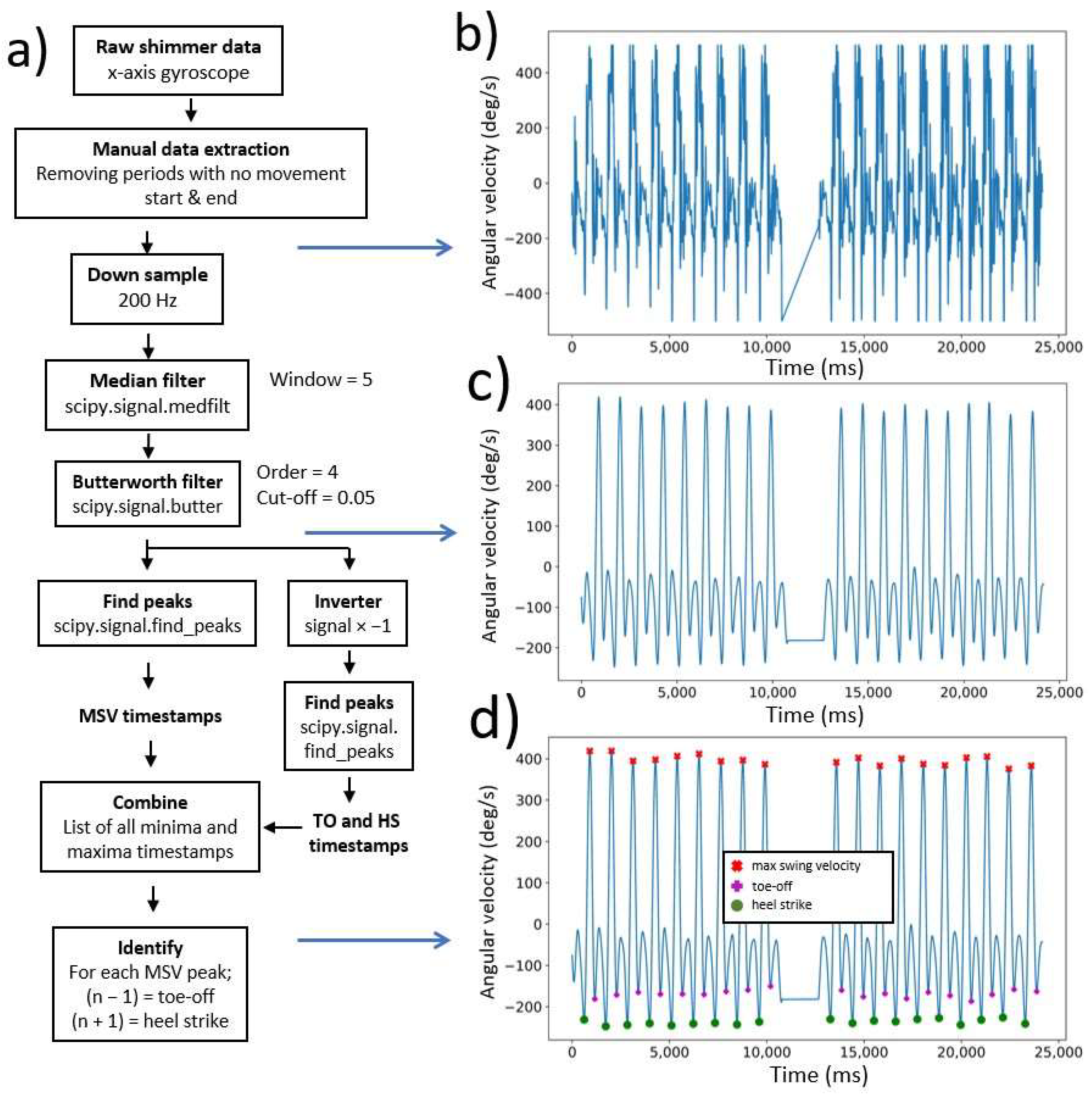

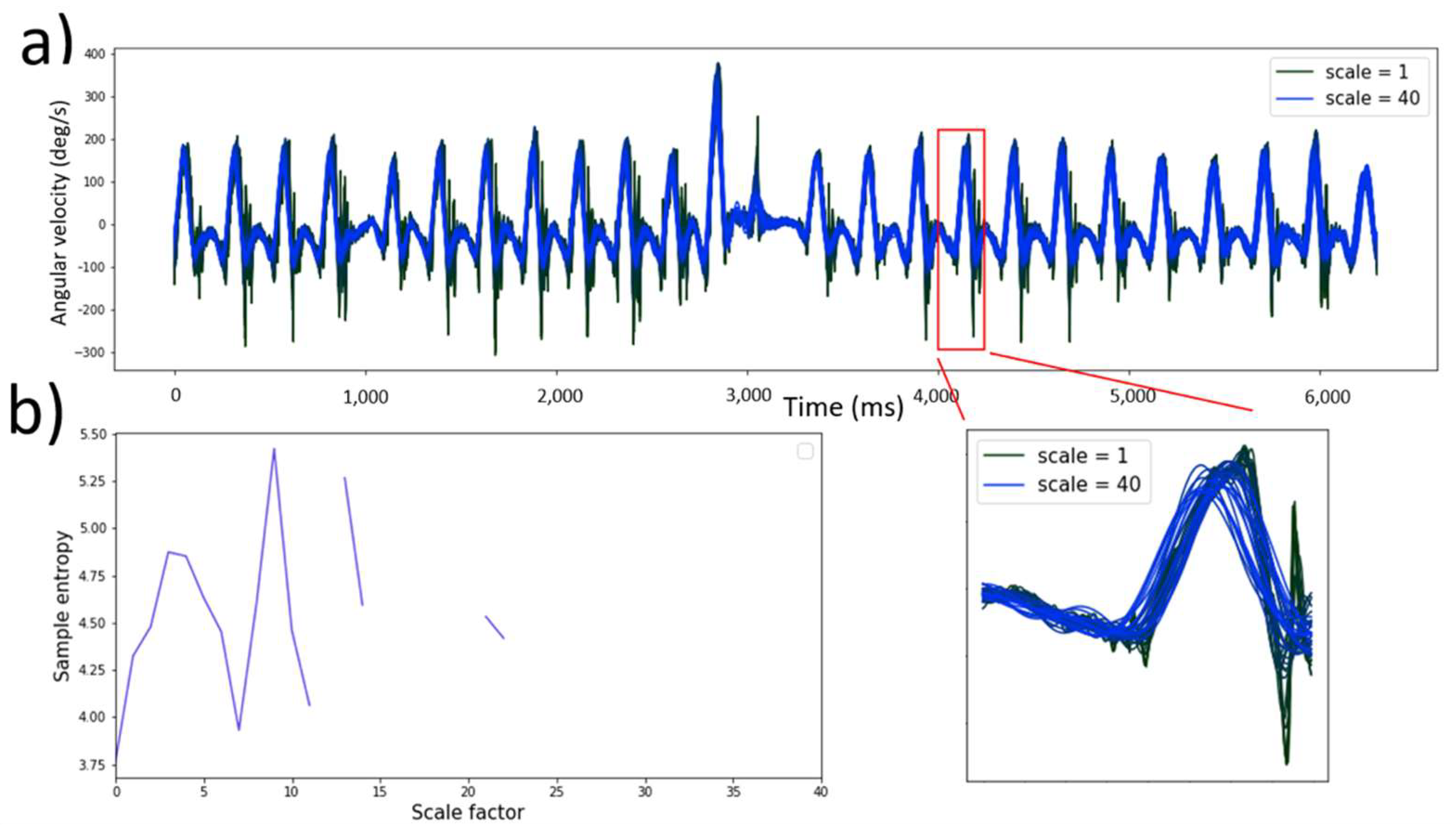
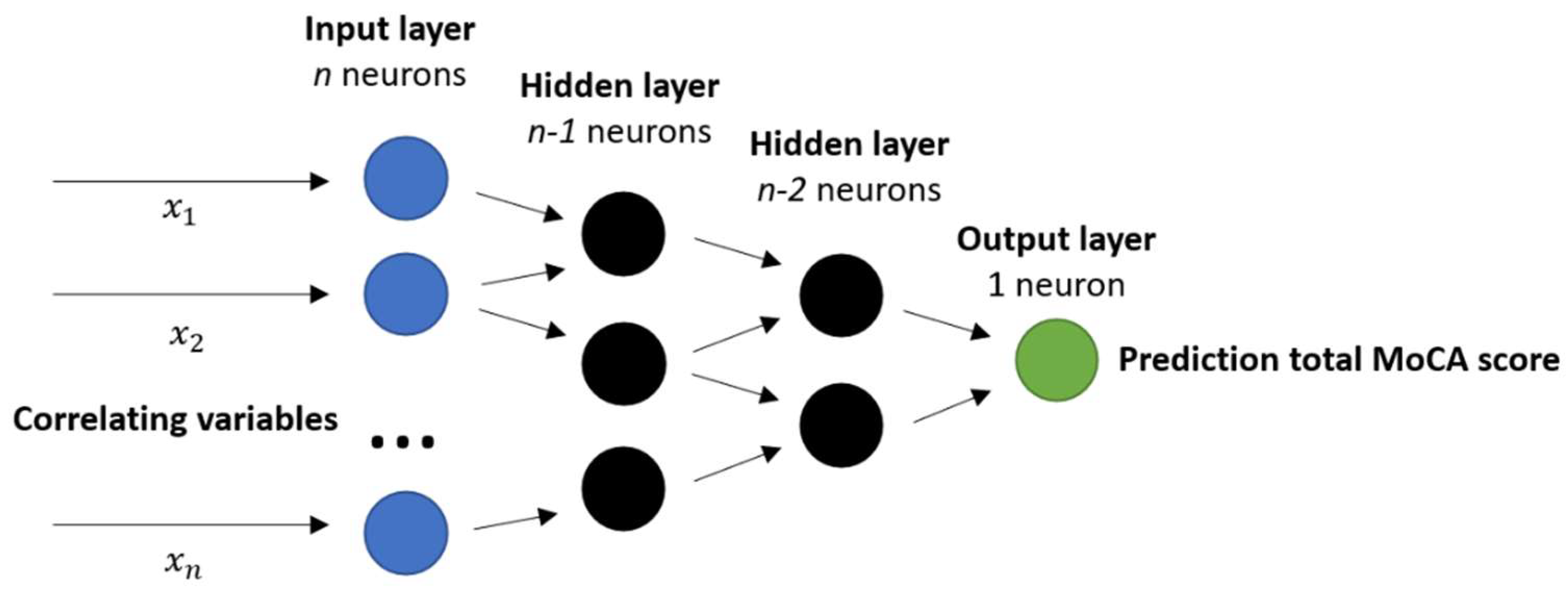

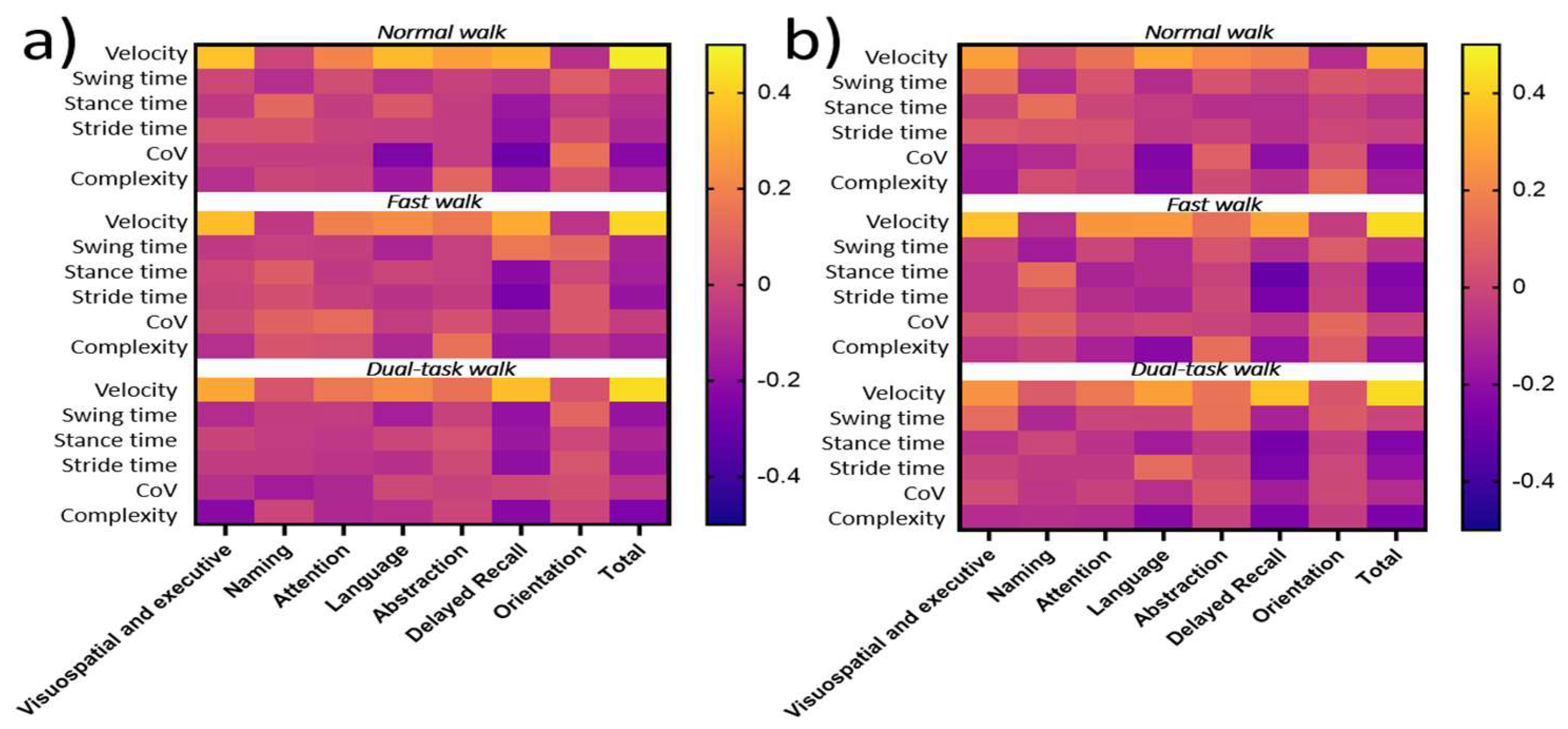
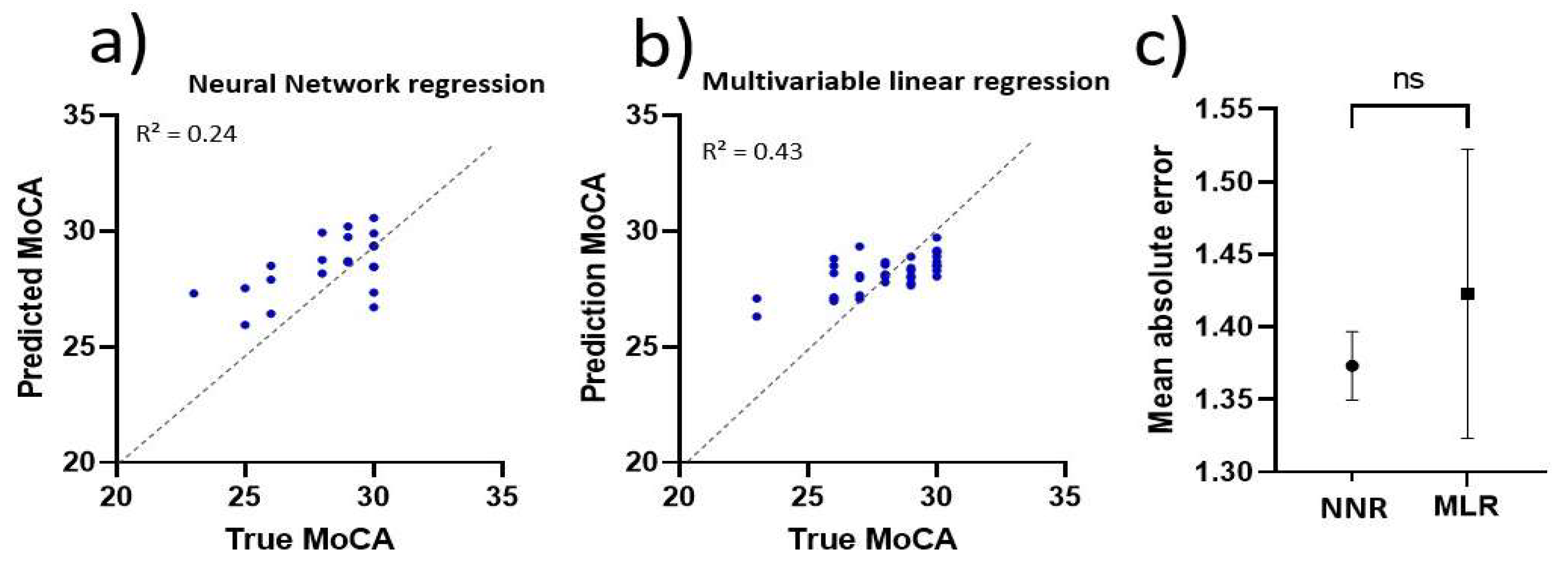
| Group | Healthy Control (n = 44) | T2DM (n = 94) | Statistic |
|---|---|---|---|
| Age | 51.9 ± 8.1 | 52.8 ± 8.3 | z = 0.47, p = 0.63 |
| Sex (Female) | 43% (19/44) | 53% female (50/94) | z = −1.04, p = 0.34 |
| BMI | 26.6 ± 3.2 | 32.4 ± 7.8 | z = 3.10, p < 0.05 |
| Years of education | 17.7 ± 2.2 | 17.2 ± 3.0 | z = −1.59, p = 0.11 |
| Variable | Healthy Control (n = 43) | T2DM (n = 94) | Statistic |
|---|---|---|---|
| Visuospatial /Executive | 4.9 ± 0.29 | 4.5 ± 0.74 | z = 1.82, p < 0.01 |
| Naming | 3.0 ± 0 | 3.0 ± 0.10 | z = −0.097, p = 0.92 |
| Attention | 6.0 ± 0 | 5.7 ± 0.61 | z = −1.28, p = 0.20 |
| Language | 3.0 ± 0.21 | 2.8 ± 0.49 | z = −1.21, p = 0.22 |
| Abstraction | 2.0 ± 0 | 1.9 ± 0.30 | z = −0.99, p = 0.32 |
| Delayed recall | 4.2 ± 0.79 | 3.9 ± 1.21 | z = −2.42, p < 0.05 |
| Orientation | 5.9 ± 0.25 | 5.9 ± 0.24 | z = −0.26, p = 0.79 |
| Total MoCA Score | 29.0 ± 0.91 | 27.7 ± 2.1 | z = −3.69, p < 0.001 |
| Variable | Healthy Controls (n = 44) | T2DM (n = 92) | Statistic |
|---|---|---|---|
| Paired Associates Learning—First Attempt Memory Score | 12.2 ± 4.1 | 10.4 ± 4.5 | z = 2.21, p < 0.05 |
| Spatial Working Memory Strategy Score | 8.5 ± 2.9 | 8.6 ± 2.5 | z = −0.19, p = 0.84 |
| Pattern Recognition Memory—Percentage Correct Delayed | 82.4 ± 14.5 | 77.5 ± 14.4 | z = −0.90, p = 0.37 |
| Median Duration Reaction Time | 409 ± 43 | 423 ± 54 | z = 0.93, p = 0.35 |
| One Touch Stockings of Cambridge—Problems Solved on First Choice | 9.6 ± 3.1 | 8.7 ± 3.4 | z = −1.47, p = 0.14 |
| Rapid Visual Processing | 0.89 ± 0.05 | 0.88 ± 0.05 | z = −0.46, p = 0.63 |
| Gait Variable | HC (n = 44) | T2DM (n = 94) | t | p | Adj. β Coeff. (95% CI) for T2DM | p |
|---|---|---|---|---|---|---|
| Left Foot | ||||||
| Normal Walk | ||||||
| Velocity (m/s) | 1.35 ± 0.16 | 1.12 ± 1.17 | 5.56 | <0.001 | −0.16 (−0.23, −0.09) | <0.001 |
| Swing time (s) | 0.50 ± 0.04 | 0.52 ± 0.05 | −1.74 | <0.05 | 0.02 (−0.00, 0.04) | 0.10 |
| Stance time (s) | 0.51 ± 0.07 | 0.54 ± 0.07 | −2.35 | <0.05 | 0.03 (−0.00, 0.06) | 0.06 |
| Stride time (s) | 1.02 ± 0.09 | 1.07 ± 0.09 | −2.96 | <0.05 | 0.05 (0.01, 0.08) | <0.05 |
| Stride time variability (CoV) | 3.14 ± 1.76 | 3.11 ± 1.51 | −0.74 | 0.87 | 1.34 (−1.61, 4.30) | 0.37 |
| Complexity index | 41.1 ± 17.2 | 55.2 ± 26.2 | −3.35 | <0.05 | 16.7 (7.23, 26.20) | <0.001 |
| FastWalk | ||||||
| Velocity (m/s) | 1.72 ± 0.19 | 1.53 ± 0.27 | 4.31 | <0.001 | −0.16 (−0.25, −0.06) | <0.001 |
| Swing time (s) | 0.48 ± 0.05 | 0.50 ± 0.07 | −1.34 | 0.91 | 0.00 (−0.02, 0.03) | 0.77 |
| Stance time (s) | 0.42 ± 0.07 | 0.44 ± 0.07 | −1.75 | <0.05 | 0.03 (−0.01, 0.06) | 0.10 |
| Stride time (s) | 0.89 ± 0.09 | 0.94 ± 0.10 | −2.43 | <0.05 | 0.03 (−0.00, 0.07) | 0.07 |
| Stride time variability (CoV) | 4.40 ± 5.14 | 4.32 ± 4.13 | 0.09 | 0.47 | 0.31 (−1.17, 1.80) | 0.67 |
| Complexity index | 25.0 ± 14.1 | 30.5 ± 20.0 | −1.86 | <0.05 | 5.95 (−1.80, 13.70) | 0.13 |
| Dual-Task Walk | ||||||
| Velocity (m/s) | 1.34 ± 0.24 | 1.21 ± 0.31 | 2.56 | <0.01 | −0.08 (−0.20, 0.03) | 0.16 |
| Swing time (s) | 0.54 ± 0.07 | 0.55 ± 0.09 | −0.89 | 0.82 | −0.00 (−0.03, 0.03) | 0.91 |
| Stance time (s) | 0.53 ± 0.12 | 0.56 ± 0.10 | −1.88 | <0.05 | 0.04 (−0.01, 0.08) | 0.13 |
| Stride time (s) | 1.07 ± 0.17 | 1.12 ± 0.16 | −1.64 | 0.07 | 0.03 (−0.03, 0.10) | 0.33 |
| Stride time variability (CoV) | 5.21 ± 3.32 | 5.80 ± 4.88 | −0.53 | 0.70 | 0.52 (−2.22, 3.27) | 0.71 |
| Complexity index | 42.1 ± 25.4 | 55.7 ± 34.1 | −2.53 | <0.05 | 11.14 (−1.73, 24.02) | 0.09 |
| Right Foot | ||||||
| Normal Walk | ||||||
| Velocity (m/s) | 1.38 ± 0.15 | 1.23 ± 0.17 | 5.05 | <0.001 | −0.14 (−0.21, 0.08) | <0.001 |
| Swing time (s) | 0.52 ± 0.04 | 0.53 ± 0.05 | −1.23 | 0.89 | −0.01 (−0.01, 0.03) | 0.26 |
| Stance time (s) | 0.50 ± 0.07 | 0.53 ± 0.06 | −2.15 | <0.05 | 0.03 (−0.00, 0.05) | 0.07 |
| Stride time (s) | 1.03 ± 0.08 | 1.06 ± 0.08 | −2.25 | <0.05 | 0.03 (0.00, 0.07) | <0.05 |
| Stride time variability (CoV) | 2.59 ± 1.16 | 2.98 ± 1.27 | 0.92 | 0.06 | 0.01 (−1.88, 1.90) | 0.99 |
| Complexity index | 40.9 ± 16.5 | 48.7 ± 22.9 | −2.08 | <0.05 | 11.65 (3.65, 19.65) | <0.001 |
| Fast Walk | ||||||
| Velocity (m/s) | 1.76 ± 0.18 | 1.56 ± 0.25 | 4.83 | <0.001 | −0.17 (−0.25, −0.09) | <0.001 |
| Swing time (s) | 0.47 ± 0.04 | 0.49 ± 0.05 | −1.47 | 0.93 | 0.01 (−0.01, 0.03) | 0.24 |
| Stance time (s) | 0.41 ± 0.06 | 0.45 ± 0.08 | −2.99 | <0.05 | 0.03 (0.01, 0.06) | <0.05 |
| Stride time (s) | 0.89 ± 0.08 | 0.94 ± 0.10 | −2.98 | <0.05 | 0.05 (0.01, 0.09) | <0.05 |
| Stride time variability (CoV) | 4.54 ± 2.72 | 4.26 ± 2.41 | −0.72 | 0.73 | 0.33 (−0.54, 1.20) | 0.46 |
| Complexity index | 22.20 ± 10.8 | 27.9 ± 17.5 | −2.09 | <0.05 | 6.97 (1.02, 12.90) | <0.05 |
| Dual-Task Walk | ||||||
| Velocity (m/s) | 1.36 ± 0.25 | 1.21 ± 0.27 | 3.51 | <0.01 | −0.15 (−0.25, −0.04) | <0.05 |
| Swing time (s) | 0.54 ± 0.07 | 0.54 ± 0.11 | 0.11 | 0.45 | −0.01 (−0.04, 0.02) | 0.47 |
| Stance time (s) | 0.53 ± 0.11 | 0.59 ± 0.14 | −2.47 | <0.01 | 0.05 (−0.01, 0.10) | 0.09 |
| Stride time (s) | 1.07 ± 0.17 | 1.13 ± 0.18 | −1.89 | <0.05 | 0.04 (−0.03, 0.12) | 0.25 |
| Stride time variability (CoV) | 5.33 ± 3.78 | 5.2 ± 3.56 | −0.69 | 0.79 | 2.04 (−1.70, 5.78) | 0.28 |
| Complexity index | 41.6 ± 26.8 | 51.9 ± 30.5 | −2.08 | <0.05 | 9.32 (−2.30, 20.94) | 0.12 |
| Parameter | |||||||
|---|---|---|---|---|---|---|---|
| Value | 5.74 | −4.39 | 1.03 | 0.61 | 1.01 | 1.21 | 21.2 |
| CI (95%) | [1.79, 9.69] | [−8.09, −0.69] | [1.79, 3.83] | [−2.33, 3.59] | [−0.45, 2.46] | [−0.38, 2.79] | [18.74–23.68] |
Publisher’s Note: MDPI stays neutral with regard to jurisdictional claims in published maps and institutional affiliations. |
© 2022 by the authors. Licensee MDPI, Basel, Switzerland. This article is an open access article distributed under the terms and conditions of the Creative Commons Attribution (CC BY) license (https://creativecommons.org/licenses/by/4.0/).
Share and Cite
Herings, P.M.R.; Dyer, A.H.; Kennelly, S.P.; Reid, S.; Killane, I.; McKenna, L.; Bourke, N.M.; Woods, C.P.; O’Neill, D.; Gibney, J.; et al. Gait Characteristics and Cognitive Function in Middle-Aged Adults with and without Type 2 Diabetes Mellitus: Data from ENBIND. Sensors 2022, 22, 5710. https://doi.org/10.3390/s22155710
Herings PMR, Dyer AH, Kennelly SP, Reid S, Killane I, McKenna L, Bourke NM, Woods CP, O’Neill D, Gibney J, et al. Gait Characteristics and Cognitive Function in Middle-Aged Adults with and without Type 2 Diabetes Mellitus: Data from ENBIND. Sensors. 2022; 22(15):5710. https://doi.org/10.3390/s22155710
Chicago/Turabian StyleHerings, Pieter M. R., Adam H. Dyer, Sean P. Kennelly, Sean Reid, Isabelle Killane, Louise McKenna, Nollaig M. Bourke, Conor P. Woods, Desmond O’Neill, James Gibney, and et al. 2022. "Gait Characteristics and Cognitive Function in Middle-Aged Adults with and without Type 2 Diabetes Mellitus: Data from ENBIND" Sensors 22, no. 15: 5710. https://doi.org/10.3390/s22155710







